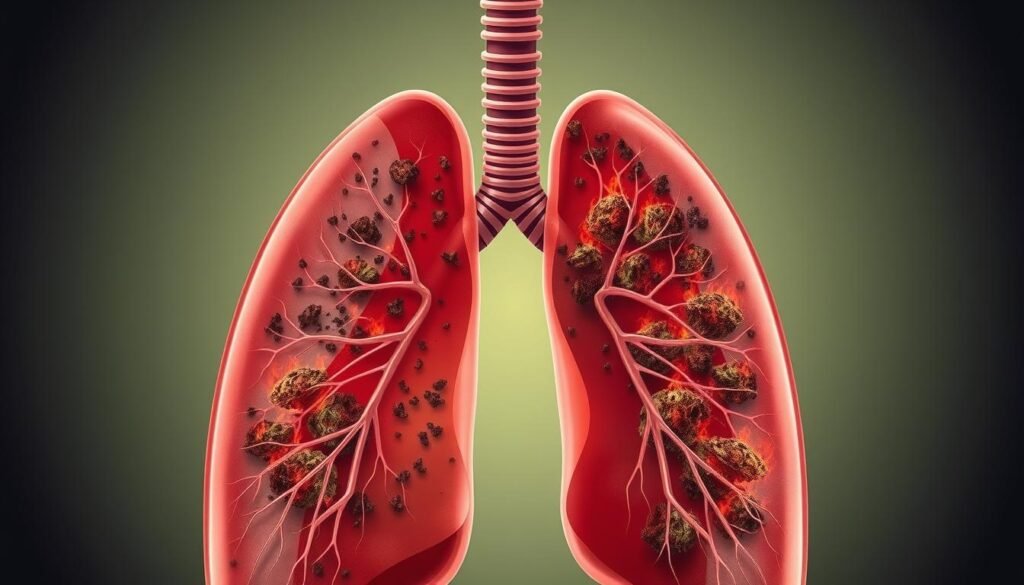About 80% of lung cancer deaths in the U.S. are due to smoking. This fact often makes us think of cigarettes. But, as people use marijuana more, we need to talk about its risks too. The American Lung Association shares worries about smoking pot. They say marijuana smoke has bad substances like tobacco smoke.
Research is showing us that smoking marijuana might not be safe for our lungs. It points to a link between smoking pot and lung problems. This includes issues that people who smoke cigarettes face. As more folks choose marijuana, learning about its effects on lungs is key.
Key Takeaways
- 80% of lung cancer deaths are linked to smoking, raising concerns about marijuana use.
- Marijuana smoke contains toxins similar to those in tobacco smoke, affecting lung health.
- Research indicates that smoking pot can lead to chronic bronchitis and lung damage.
- The American Lung Association emphasizes the damaging effects of marijuana on lung health.
- Continued studies are necessary to understand the association between marijuana and lung cancer risks.
Understanding Cannabis and Its Use
Cannabis, commonly known as marijuana, is getting a lot of attention lately. People use it for fun recreational use and health reasons medical use. There are various ways to enjoy cannabis like smoking, using bongs, or eating edible treats. Each method affects health differently, especially the lungs.
Research is shedding light on these consumption methods. Cannabis can help relieve nausea and pain. But, it’s also important to know its risks. For example, smoking anything can hurt your airways, causing issues like coughing and breathlessness.
Studies point out that marijuana smoke has some harmful substances as tobacco smoke. Regular smokers should be wary, especially if it’s a frequent habit. Yet, studies show that it doesn’t majorly impact lung function or lead to COPD. Still, long-term use needs careful thought.
User habits can affect lung health too. Weed smokers tend to inhale deeper and keep the smoke in longer than tobacco smokers. Those concerned about lung health might want to look into other ways of using cannabis.
Cannabis is being embraced more for its medical and leisure benefits. Knowing about its consumption and health effects helps users make smarter choices. If you’re curious about its health risks, especially smoking, read more here.
| Method of Consumption | Potential Health Implications |
|---|---|
| Smoking (Joints, Bongs) | Increased risk of respiratory symptoms and exposure to carcinogens |
| Edibles (Candies, Brownies) | Lower lung health risks, systemic effects may vary |
| Vaporization | Perceived as less harmful but still poses risks to lung health |
The Composition of Marijuana Smoke
Marijuana smoke has a complicated composition of smoke that worries health experts. It is similar to tobacco smoke because it releases tar, ammonia, and toxic chemicals. These include harmful substances like benzo(a)pyrene, phenols, and nitrosamines. They can significantly harm the lungs.
Studies show that marijuana smoke might have more carcinogenic compounds than tobacco smoke. This is often due to how people smoke cannabis – by inhaling deeply and holding the smoke in. So, it’s important for users to know about these health risks, especially concerning lung cancer.
Research suggests that smoking marijuana can lead to chronic bronchitis and other lung problems. Therefore, it’s crucial to understand what you’re inhaling. There’s a need for more research to fully understand how marijuana affects lung health. For those interested, further information on risks is available at this page.
| Harmful Substance | Impact |
|---|---|
| Benzo(a)pyrene | Known carcinogen associated with cancer risk |
| Phenols | Can cause airway irritation and inflammation |
| Nitrosamines | Linked to various cancers and respiratory issues |
| Tars | Contributes to bronchitis and lung damage |
| Ammonia | May worsen lung function and lead to respiratory complications |
Smoking Pot and Lung Cancer: Health Risks Explained
The debate over smoking pot and lung cancer is intense. Studies show a worrying link. Regular use may sharply raise the risk of lung cancer. For every joint-year of cannabis smoked, lung cancer risk jumps by 8%.
Heavy users of marijuana are at an even more considerable risk. Smoking pot brings harmful chemicals to the lungs. For instance, benzopyrene and benzanthracene are more concentrated than in tobacco. This likely ties marijuana to some cancers, like those in the throat.
As marijuana becomes more accepted, knowing these risks is key. It allows people to choose wisely about using pot. The connection between cannabis and various cancers is a major topic in health talks, especially as more states legalize it.
| Health Risks of Smoking Pot | Study Findings |
|---|---|
| Increased Lung Cancer Risk | 8% rise per joint-year of cannabis smoking |
| Heavy Marijuana Users | Significantly elevated relative risk for lung cancer |
| Substances in Marijuana Smoke | Higher levels of carcinogens compared to tobacco |
| Marijuana and Other Cancers | Links to upper aerodigestive and testicular cancer |
| Secondhand Smoke | Contains similar toxins as directly inhaled smoke |
Keeping up with research on pot smoking and lung cancer is vital. Marijuana’s growing use highlights the need for education. People must understand the possible health risks.
How Marijuana Smoke Affects Lung Health
Marijuana smoke can harm your lungs, similar to cigarettes. It’s linked to chronic bronchitis and weakening the immune system. Smokers might face coughing and phlegm issues. It’s important to know how smoking pot might lead to lung infections, more so for those already sick.
Chronic Bronchitis and Respiratory Issues
Chronic bronchitis is a big worry for pot smokers. They often cough and produce a lot of sputum. Studies show that though pot increases lung capacity, it doesn’t damage the airways like tobacco does. Quitting pot can improve breathing and lower bronchitis risk.
Immune System Suppression
Marijuana smoke can also weaken your immune defense. This makes you more likely to get sick, especially if you have asthma or HIV. Smoking pot regularly can affect your body’s defense against diseases. It’s key for smokers to consider their lung health when using cannabis.

Knowing the risks of smoking marijuana is more important than ever. As more people use cannabis, understanding its health risks matters. For tips on keeping your lungs healthy and detecting problems early, visit this informative resource.
Carcinogenic Exposure from Marijuana Smoke
It’s important to understand the health risks from marijuana smoke. This smoke has irritants and toxins similar to tobacco. It contains dangerous compounds like polycyclic aromatic hydrocarbons. These can harm lung tissue and increase lung cancer risk.
Toxins and Irritants in Marijuana Smoke
Cannabis smoke’s toxins are concerning. Studies show it may have four times more tars than tobacco. This means users face more harmful substances. Benzo(a)pyrene and Phenols, which may cause cancer, are among these substances.
Regular users could see changes in their lung tissue. This suggests a risk of serious health problems. Conditions like inflamed breathing tubes and chronic bronchitis are possible.
Marijuana and tobacco share many harmful chemicals. This is worrying for regular users. The direct link between cannabis smoking and lung cancer is unclear. But, the carcinogenic exposure from marijuana demands more research. This is vital as its use grows in popularity.
Comparison Between Marijuana and Tobacco Smoke
Smoking and its health risks differ when comparing marijuana to tobacco. Both have harmful substances but in different amounts and types. The cancer-causing effects vary widely between them.
Cannabis smoke contains more carcinogenic polyaromatic hydrocarbons than tobacco smoke. This is partly because cannabis smokers often don’t use filters, like those smoking unfiltered tobacco. They also inhale more deeply and hold the smoke in longer, which increases the amount of harmful substances in their lungs.
Studies show lung cancer risk exists with marijuana but it’s not the same as with tobacco. Smoking one joint adds 8% to your lung cancer risk. But smoking a pack of cigarettes increases your risk by 7%. Heavy marijuana users have a 5.7 times higher risk of lung cancer, depending on how much they use.
Still, tobacco is generally more deadly, causing nearly 443,000 deaths in the U.S annually. Marijuana might seem less harmful, but it’s still risky, especially for those with lung problems.

Knowing these differences can help you make better decisions about smoking. For more details, check out the research available here.
| Factor | Marijuana Smoke | Tobacco Smoke |
|---|---|---|
| Carcinogenic Content | Higher concentration of carcinogenic polyaromatic hydrocarbons | Standardized levels based on cigarette manufacturing |
| Smoking Pattern | Inhaled deeply; held longer | Varies; often includes filters |
| Lung Cancer Risk Increase | 8% per joint-year | 7% per pack-year |
| Population At Risk | Higher relative risk for heavy users | Broad population impacted due to high usage rates |
| Annual Deaths | Under investigation; fewer records | Approximately 443,000 in the U.S. |
Research Studies on Lung Cancer Risks
Research on cannabis use and lung cancer shows mixed results. Some studies suggest marijuana may increase lung cancer risks. They report that lung cancer risk grows by 8% for every joint-year of smoking. This raises key concerns about marijuana’s health effects.
Case-Control Studies Findings
Several studies hint at a link between cannabis and lung cancer, especially in young adults. A major study found 79 lung cancer cases among 324 control subjects. It revealed that heavy cannabis use could multiply lung cancer risk by 5.7 times. This highlights the complexity of cannabis-related lung cancer risks.
Conflicting Evidence on Cannabis and Lung Cancer
Yet, not all studies agree on the risk. Some research shows no clear link between heavy marijuana use and lung cancer. Light and moderate use seems not to heighten the risk for lung or throat cancer. Despite similarities to tobacco, heavy cannabis use carries less lung cancer risk than heavy tobacco use. This points to the need for more research on cannabis and lung cancer.
| Factor | Impact on Lung Cancer Risk |
|---|---|
| Joint-Year of Cannabis Smoking | 8% increase per joint-year |
| Pack-Year of Cigarette Smoking | 7% increase per pack-year |
| Highest Tertile of Cannabis Use | 5.7 times increased risk |
| Sample Size (Lung Cancer Cases) | 79 cases |
| Sample Size (Controls) | 324 controls |
| Power to Detect Odds Ratios | 80-90% to detect ratios of 2.4 to 2.7 |
Secondhand Smoke Dangers from Marijuana
Secondhand marijuana smoke is dangerous for lung health, similar to tobacco smoke dangers. It contains toxic and cancer-causing substances like acetaldehyde and formaldehyde. In fact, marijuana smoke has some toxins in higher levels than in tobacco smoke. This is worrying for public health and for people like children or those with bad health.
Children in homes where marijuana is used can have THC in their system. THC is the part of cannabis that affects the mind. It might hurt their growth and how well their brain works. Studies show that if cannabis is used at home, children are likely to have THC in them. This means we need to be more aware of the risks of secondhand smoke.
Marijuana smoke puts out more fine dust (PM2.5) than tobacco does. A regular marijuana joint puts out 3.5 times more PM2.5 than a Marlboro cigarette. This is a big worry for air cleanliness in places where marijuana is smoked. For example, air measurements in dispensaries reached 840 µg/m3.
Secondhand marijuana smoke causes environmental health problems like tobacco smoke does. As more people use cannabis, it’s important to have rules that keep our air clean. We must protect our lungs and keep everyone safe from the harm of secondhand marijuana smoke.
| Substance | Secondhand Marijuana Smoke | Secondhand Tobacco Smoke |
|---|---|---|
| Ammonia | 3 times higher | Present |
| Fine Particulate Matter (PM2.5) | 3.5 times higher from pre-rolled joints | Baseline emissions |
| Acetaldehyde | Present | Present |
| THC (passed to children) | Detected in households | Not applicable |
| Cancer-Causing Chemicals | 33 identified | Present |
Addiction Concerns and Behavioral Effects
It’s important to understand how marijuana can lead to addiction, both for users and society. Not all people who use marijuana get addicted. But the risk of dependence goes up with regular use, especially for teens. Using marijuana in the teen years can harm learning, memory, and even lower IQ.
Teens using marijuana might face several behavioral issues. These include trouble thinking clearly and other mental health problems. This shows why we need to know about the risks marijuana poses to mental health. Using marijuana can raise the chance of having anxiety, mood problems, and more serious conditions like psychosis or schizophrenia, especially if these illnesses run in the family.
Marijuana use can also bring about unsafe situations. For example, driving under the influence of marijuana greatly increases the chance of car crashes. Plus, there are dangers with strong marijuana edibles, such as accidental intake or taking too much. This shows why using marijuana safely is so important.
Even though cannabis can help with some medical issues, we have to be careful about misusing it. This is especially true for people with serious conditions like cancer. Using marijuana can complicate health problems and treatments, so it requires thoughtful consideration.
Substance Abuse and Prevention Strategies
Addressing substance abuse, especially with marijuana, needs a detailed plan. Education is key to tell people about the dangers of cannabis use. Community awareness efforts can really help cut down its misuse by supporting responsible use.
Young people must get the facts on how marijuana affects health, especially the lungs. Research shows that smoking it can harm lung tissue and damage small blood vessels. Since cannabis smoke has harmful toxins like tobacco smoke, learning all about this is crucial.

Educational programs can teach about the signs of substance abuse, helping others get support early. Talking about marijuana’s effects in families and schools creates a culture of knowledge and support. This way, when cannabis is used, it is done so with caution and understanding.
- Implement community outreach programs focused on marijuana education.
- Encourage open dialogue about substance use within families.
- Provide resources for individuals struggling with substance abuse.
Talking openly about substance abuse risks, including marijuana, improves public knowledge. Communities with strong prevention strategies see fewer health issues from cannabis. Through education, people can choose healthier lifestyles.
Conclusion
Talking about smoking pot and lung cancer shows that health risks need careful thought. Early studies hinted at a link between long-term use of marijuana and lung cancer. But more recent work shows the risk might not be as high as tobacco’s. The key issues are things like harmful exposure and how it inflames the airways. These make choosing wisely about using marijuana important for lung health.
Also, it’s key to know that marijuana smoke might cause some breathing problems. Yet, current research doesn’t link it to lung cancer like tobacco smoke does. This highlights the need for more studies. They can help us better understand how marijuana affects lung health. Staying informed helps people make safe choices about using cannabis.
For those worried about the risks, trying other ways of using cannabis, like edibles, can cut down on harmful smoke. The world of cannabis research is always changing. People can look up the latest findings to keep informed. Being knowledgeable leads to smarter, safer cannabis use. To learn more about marijuana smoking and lung cancer risks, check out more studies here.